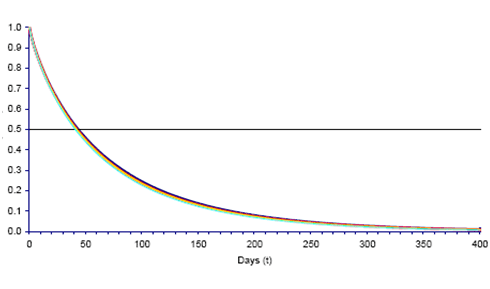| Show/Hide Hidden Text |
If a person is not back at work within three weeks urgent attention is needed.

This graph shows that the likelihood of return to work goes down the longer the person is off work. If the person is not back by:
| • | 20 days the chance of getting back to work is 70% |
| • | 45 days the chance of getting back to work is 50% |
| • | 70 days the chance of getting back to work is 35% |
The first few weeks are crucial. If work absence continues beyond a few weeks it is time to "pull out all stops".
Assess the influencing factors?
Have the basics of return to work been done? Has the workplace called the employee to provide support, ask what can be done to help, openly discussed return to work? Has the employee been advised of the company's policies and procedures for injury management and relevant pay issues? Did communication with the treating practitioner take place early, preferably before the employee was seen by the doctor? Does the employer have a proactive approach to the management of work disability? Does the workplace have a partnership with employees to assist them back to work? Are employees actively engaged in the process of return to work management? Take a deeper look at influencing factors A serious medical condition may require a longer time off work, however this is an uncommon situation.
Is the supervisor an active player?
Does the supervisor understand this? Are they comfortable communicating with the employee about personal matters? Are they a good listener? Do they understand the importance of their role? Do they need support themselves? |
The key people to involve are the employee and their supervisor. How that is done depends on the person and the situation. The principles of management include: A relationship of trust allows better and deeper communication The supervisor is usually the best person to talk to the employee. If this is not possible involve someone at the site who the employee has confidence in. This may be the department manager, production manager, human resources staff, the return to work coordinator, or the site nurse. Ensure the focus is on the person's well being In the quest to reduce lost time injuries (LTIs) the attention might have been on statistics rather than the employee. Ensure the person's well being is the priority and that they understand this. Communicate the importance of return to work as part of their recovery, and the urgency of the matter. Many people are not aware of the long term problems that result from staying off work. Staying off work in the short term significantly increases the chance that they will be off work in the long term. Talk openly, for example: "We know it is important for your health to get back to work early. People who stay off work get isolated and depressed, and become less fit. It doesn't take long for these things to start. What can we do to help?" Get the employee involved
Who else should be involved? When the important people get involved, actions and outcomes are more likely. Ask the CEO or MD to give the person a call and check on their well being. Employees feel cared for, significant and engaged. (The boss also gets involved, with a heightened interest in the outcome). The supervisor and other managers will be more active when they are aware that management is interested in the issue. Arrange a team meeting with the supervisor, human resources and senior management. Discuss the factors impacting the situation and plan strategies to deal with the issues. A common feature of long term cases is a lack of understanding and management of the key issues in the early stages. Does the employee have a lingering gripe about a pay issue, being passed over for promotion, a roster change that was recently introduced? Do they have a spouse with health problems and need assistance? |
The best way to influence the doctor or other treating practitioners is by influencing the employee. If the employee wants to be back at work, nine times out of ten, the doctor will agree. Other important components include: Make sure the doctor is aware of the company's approach
Let treaters know how important you consider return to work to be for your employee. Tell the doctors and other treaters that you know the chances of return to work goes down significantly if your employee is not back at work within weeks. And that you will do what you can to support the employee. Positive influences
|
Involve others: If there is a workplace relations issue blocking return to work, involve an industrial or organisational psychologist. Unless the problem is dealt with, return to work will not happen, or be slow, difficult and less likely to be successful. Arrange an independent medical review by an Occupational Physician, with or without a work site visit. The simple action of arranging a review can sometimes prompt change, once the employee or treater becomes aware of the activity and other medical input. Use any further medical information, such as an independent medical report, to constructively influence the situation. "Dr Y recommends these restrictions, are these suitable, or do you recommend other restrictions?" Review the situation with the case manager at the insurer or Work Cover Agent. What do they believe is needed, what strategies can they offer or recommend? Consider using an occupational rehabilitation provider to assist, if things are not progressing as expected. What does the medical evidence recommend for the person's condition? Prompt the person and their treaters to use best practice, print out and give them, or send them, relevant information from www.rtwknowledge.org |
![]() Next Step:
Next Step:
Return to work approaches